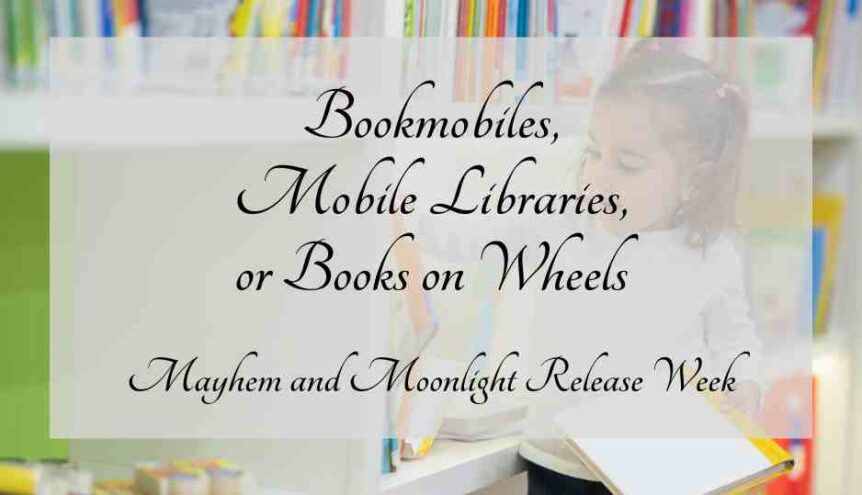 Bookmobiles, traveling libraries, book wagons, book trucks, books-on-wheels…whatever your preferred title, there are almost 700 of them in the U.S. today. What would be a series on libraries if we didn’t include this historic gem? The first of its kind was a horse-drawn van started in Warrington, England in 1859 and was called the Perambulating Library (yeah, bookmobile is much simpler).
Bookmobiles, traveling libraries, book wagons, book trucks, books-on-wheels…whatever your preferred title, there are almost 700 of them in the U.S. today. What would be a series on libraries if we didn’t include this historic gem? The first of its kind was a horse-drawn van started in Warrington, England in 1859 and was called the Perambulating Library (yeah, bookmobile is much simpler).
I knew nothing about bookmobiles until my daughter became a “mobile librarian” here in Middle Tennessee a couple of years ago. She had a van loaded with books and other library paraphernalia that she would haul to different locations in order to bring library services to those in need.
When launching into research about bookmobiles, I discovered some conflicting information. What the American Library Association (ALA) claims is different from other sources. The only way I know to be fair is to share a bit from both camps.
According to the ALA, the first bookmobile in the United States was established in the Washington County Public Library in Maryland in 1905. This horse-drawn wagon had room for 200 books. However, (and here is where the discrepancy begins) there are historic accounts of mobile libraries started in Waco, Texas by the president of the Texas Federation of Women’s Clubs much earlier. In fact, those sources claim there were hundreds of mobile libraries (the horse-and-cart variety) in New York City before 1900. Either way, bookmobiles or mobile libraries have been around for a very long time.
By 1920, Sarah Byrd Askew, a pioneering librarian, began using her Model T to transport library books to rural New Jersey locations. Then horse-drawn vans took over. By the mid-1900s, trucks became more popularly used. Today, with the advancement in technology, many bookmobiles have WiFi hotspots, mobile computers labs, and more in their buses and vans.
According to author Sharlee Glenn in her novel Library on Wheels: Mary Lemist Titcomb and America’s First Bookmobile, the 1960s and ’70s was the heyday for bookmobiles. Glenn says that during that time, there were at lease 2,000 mobile libraries touring the U.S. I can see that. It seems like just the thing to fit into that time period of our history.
During the 1960s, author W. Ralph Eubanks, remembers bookmobiles stopping on is street in Southern Mississippi. “The librarians did not care that I was barefoot, and wearing a pair of raggedy shorts. All they cared about was that I wanted to read—and to help me find something I would enjoy reading.” The summer just before Eubanks turned 11 years old, he discovered books by William Faulkner on the shelves. It was the first time he’d read an author from Mississippi, and it was what made him realize that someone from his part of the world could also become a writer.
Ralph Eubanks is now the acclaimed author of A Place Like Mississippi: A Journey Through a Real and Imagined Literary Landscape. Considering he is also the director of publishing for the Library of Congress, I’d say that the bookmobile made a tremendous impact on his life. If you’d like to read more about him, here is a link to the post “Long Overdue, the Bookmobile Is Back” by Jeff Greenwald.
Historically, the focus of bookmobiles was on delivering books to those in the community who didn’t have access. Even when my daughter was driving her mobile library, she was reaching some of the poor and elderly communities. Many times, she’d have a scheduled stop at a school, where the kids would flock to the van to pick out their free book.
Many mobile library units now offer much more than books. Some library districts use their bookmobiles to host classes throughout the community such as computer literacy and language. Others use them for creative art centers for people of all ages. And still others use them for event-focused spaces in partnership with local organizations to host educational classes.
Interestingly, for decades, the state of Kentucky has consistently had the most mobile libraries in the U.S. Sandra Hennessee began driving bookmobiles in 1995 and visited child care centers, preschools, assisted living facilities, and farms. In 2017, she delivered somewhere in the ballpark of 1,600 books a month—nearly a fourth of the entire county library books borrowed.
I’d love to know if you have a bookmobile in your community. I know our public library was searching for the funds to be able to offer that here. What a blessing it is to give the gift of a library to those who are cut off from what most of us take for granted.
I couldn’t find any free images of bookmobiles, so I’m sharing this website of vintage photos instead. Enjoy!
Come back tomorrow for release week post, and don’t forget to enter for a chance to win a $25 Amazon Gift Card.
You can still get the ebook version of Mayhem and Moonlight for the preorder price of $2.99. Be sure to claim your preorder gift by filling out the form from my publisher’s website. Just have your Amazon order number handy. If you prefer the paperback version, it is now available and already includes the preorder gift.







Comments 1
I seem to remember that our library had a mobile library during the summer in the parts of Tulsa that didn’t have access to a regional library. Mobile libraries, bookmobiles, have helped many.